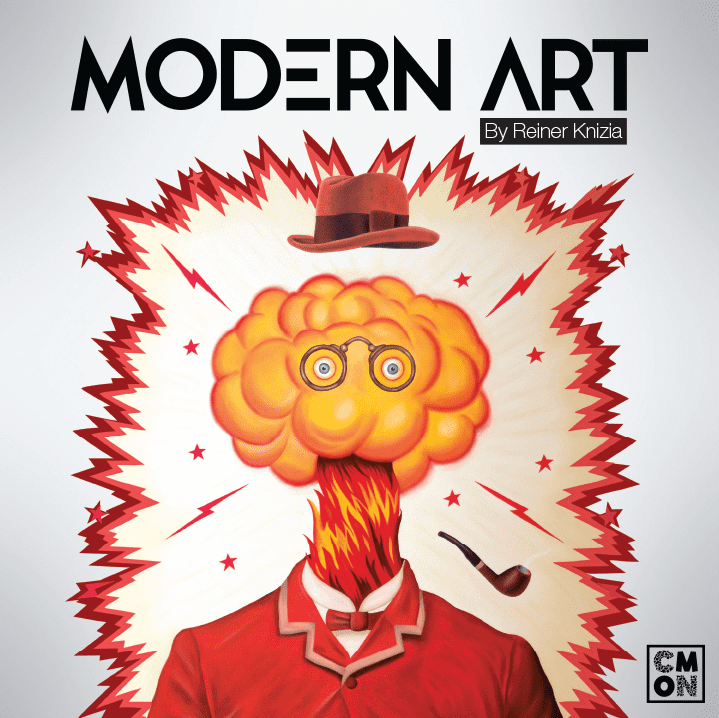Overview
Welcome to my review of Modern Art, an exhilarating and strategic board game that will transport you into the world of art dealing. In this review, we will take an in-depth look at the gameplay mechanics, artwork and visual design, player interaction and strategy, as well as the replayability and lasting appeal of this captivating game.
How It Plays
In Modern Art, players immerse themselves in the competitive world of art dealing. The game is divided into several rounds, each of which represents a season in the art market.
Setting up
At the start of the game, players shuffle the deck of artwork cards and place them face-down in a draw pile. Several artists are randomly chosen and placed face-up in a row, forming the auction market. Each player is then given an initial amount of money.
Gameplay
During each round, players take turns being the auctioneer. The auctioneer reveals an artwork card from the draw pile and sets the opening bid for that painting. The other players then have the opportunity to raise the bid or pass. If all players pass, the auctioneer has the option to purchase the painting at the last bid price.
In addition to bidding, players can also sell paintings from their collection during other players’ auctions. These sales can be risky, as the market value of paintings can fluxutate over the course of the game. Strategic timing and pricing are key in making profitable sales.
Winning the game
The game of Modern Art ends when the draw pile of artwork cards is depleted. At this point, players tally up the final values of the paintings they have accumulated during the game. The player with the highest total amount of money wins the game, as this represents their profit as an art dealer.
Want to know more? Read our extensive strategy guide for Modern Art.
When it comes to gameplay mechanics, Modern Art delivers an engaging and strategic experience that keeps players on their toes. Each player takes on the role of an art dealer, buying and selling paintings to try and make the most profit. The game revolves around a unique auction system, which keeps the pace fast and the tension high.
An Exciting Auction System
In Modern Art, auctions are the heart and soul of the game. Players take turns being the auctioneer, setting the opening bid for one of the artwork cards that are up for sale. Then, the other players have the chance to place higher bids or pass. The auction can quickly become fierce as players try to outbid each other, knowing that the value of the paintings can fluctuate dramatically as the game progresses. This auction dynamic creates a thrill similar to the real art market and adds an element of excitement to Modern Art.
Role of Strategic Planning
While luck does play a role in Modern Art, strategic planning is key to success. As players vie for artworks, they must carefully manage their resources and anticipate the market trends. Analyzing the demand for certain artists and styles is crucial for making profitable bids and sales. Balancing short-term gain with long-term investments is a constant challenge that keeps players engaged and mentally stimulated throughout the game.
Different Artists, Different Strategies
One aspect that enhances the gameplay mechanics of Modern Art is the variety of artists featured in the game. Each artist has specific attributes that can influence their market value. Some might have higher starting bid values or trigger special actions when sold. Players need to adapt their strategy based on the artists available each round, making each game unique and requiring a different approach. Flexibility and adaptability are key to mastering the gameplay mechanics of Modern Art.
A Visual Feast for the Eyes
As the auction unfolds, players can enjoy the stunning artwork and visual design of Modern Art. The game features a wide range of art styles, from abstract to impressionist, each beautifully illustrated with vibrant colors and attention to detail. The artwork adds an immersive element to the game, transporting players into the world of art dealing.
The appealing visual design serves a practical purpose, too. Each artwork card is easily distinguishable, allowing players to quickly assess their options and make informed decisions during the auction. The combination of artistry and functionality makes Modern Art a visually pleasing board game that enhances the overall gameplay experience.
Next, we’ll delve into the captivating aspect of player interaction and strategy in Modern Art.
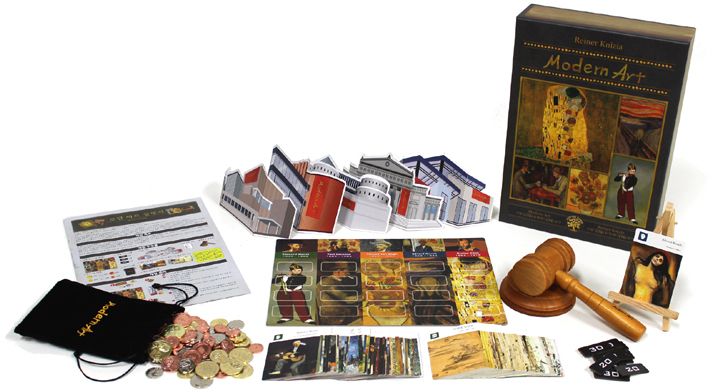
A Feast for the Senses: Amazing Artwork and Visual Design
In Modern Art, the artwork and visual design are undeniably a standout feature that immerses players in the world of art dealing. The game boasts stunning illustrations and a diverse range of art styles, which enhance both the aesthetic appeal and gameplay experience.
Vibrant and Engaging Art Styles
The variety of art styles featured in Modern Art is an absolute delight. From abstract paintings that ooze creativity to realistic depictions that capture the essence of the artists’ vision, there is something for every art enthusiast. The attention to detail and color palettes used in the artwork make each card a visual masterpiece, constantly captivating players’ attention.
Functionality Meets Beauty
Not only does the artwork in Modern Art evoke awe, but it also serves a functional purpose. Each artwork card is distinct in style and design, making it easy for players to quickly recognize and assess their options during the auction. The clear visual cues provide a seamless user experience, allowing players to make informed decisions efficiently.
Immersive Atmosphere
The combination of compelling artwork and engaging visual design creates an immersive atmosphere in Modern Art. The illustrations capture the essence and energy of artistic movements, taking players on a journey through the captivating world of art dealing. Whether you are appreciating the art or strategizing your next move, the visuals draw you into the game and enhance the overall enjoyment and thematic experience.
The next section will delve into the dynamic aspect of player interaction and strategy in Modern Art, where minds clash and fortunes rise and fall.
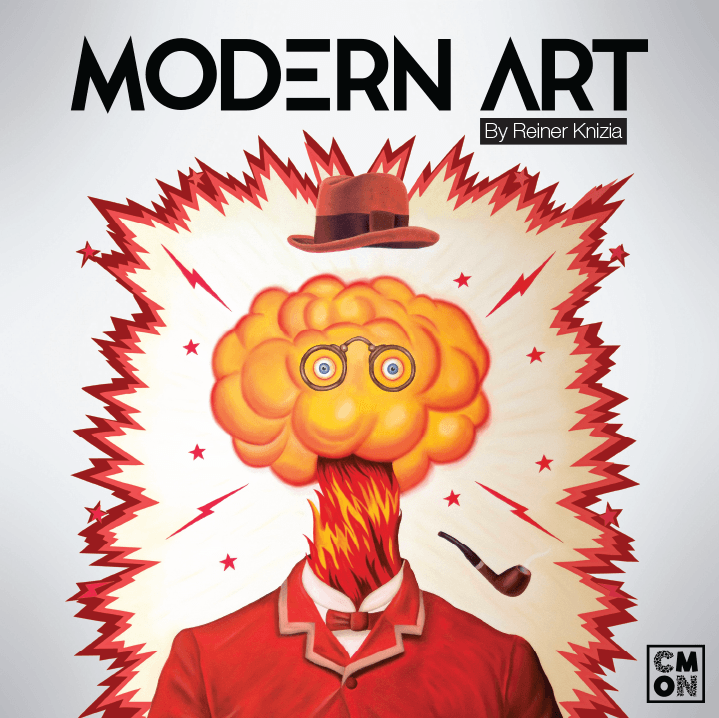
Mind Games and Strategic Maneuvers: Player Interaction and Strategy
Modern Art is a game that thrives on player interaction and strategic decision-making. Throughout the game, players must navigate the art market, assess their opponents’ moves, and adapt their strategies in order to come out on top.
A Dynamic Auction Experience
The auction system in Modern Art serves as a focal point for player interaction. As players engage in fierce bidding battles, they must carefully observe their opponents, anticipating their moves and adjusting their own bids accordingly. The ability to read other players’ intentions and react strategically is essential for success, creating an intriguing atmosphere of psychological gameplay.
The Art of Timing and Pricing
In Modern Art, knowing when to sell and when to hold paintings can make all the difference. Players need to gauge the market demand and carefully time their sales to maximize their profits. Strategic considerations come into play, as players need to balance achieving high prices for their paintings with the risk of oversaturating the market and devaluing their own investments. This delicate balance adds layers of depth and decision-making that keep players engaged and challenged throughout the game.
Player Rivalries and Tactics
Building a collection of valuable paintings is not the only path to victory in Modern Art. Players can also disrupt their opponents’ plans and overcome hurdles by employing clever tactics. This aspect of the game adds a playful element of rivalry, as players strategize ways to undercut their opponents’ bids or manipulate the market to their advantage. The strategic interaction between players creates a highly engaging and unpredictable gameplay experience, as each move can have lasting consequences.
Champion players emerge victorious from epic bidding wars with pockets full of masterpieces and rivals left in awe of their strategic acumen.
Replayability and Lasting Appeal
One of the factors that make Modern Art stand out is its high replayability and lasting appeal. The game offers a multitude of variables, such as the art style variations and the shift in market demand, that contribute to a different experience in each playthrough. Players can constantly refine their strategies and adapt to the changing dynamics, guaranteeing that no two games are ever the same.
The combination of player interaction, strategy, and the variability of gameplay factors make Modern Art a game that gets better with each play. As players sharpen their skills and explore new tactics, they unlock the true depth and intricacies behind successful art dealings.
Next, we’ll uncover the final facet of Modern Art: its replayability and lasting appeal in the modern board gaming world, ensuring it stays in the collection for years to come.
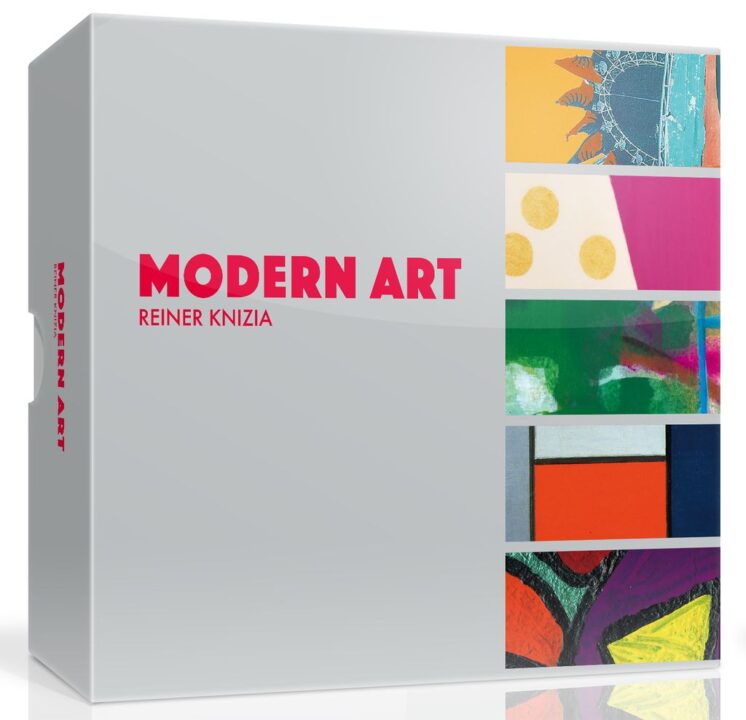
Endless Possibilities: Replayability and Lasting Appeal
Modern Art is a game that continues to enchant and captivate players even after multiple playthroughs. Its high replayability and lasting appeal can be attributed to several factors that make it a standout in the world of boardgames.
Variable Art Styles and Artists
One aspect that contributes to the game’s replayability is the variety of art styles and artists featured in Modern Art. Each playthrough introduces players to different artworks, requiring them to adapt their strategies and explore new approaches to success. The uniqueness of each artist and their distinct attributes keeps the game fresh and exciting, as players discover new favorites and unexpected combinations.
Dynamic Market Demand
The shifting market demand adds a layer of unpredictability to each game of Modern Art. The popularity and value of different art styles fluctuate as the game progresses. This variability creates dynamic gameplay, ensuring that players must constantly reassess their strategies and adjust their plans accordingly. With each playthrough, players are faced with new challenges and opportunities, making Modern Art a game that remains engaging and mentally stimulating for years to come.
Endless Strategic Exploration
The depth of strategy available in Modern Art ensures that players can explore different approaches and tactics with each playthrough. The interplay between player interaction, bidding wars, and timing creates a rich strategic landscape. From manipulating the market to outsmarting opponents, Modern Art offers multiple avenues for victory and encourages players to experiment with unique strategies, keeping the game fresh and exciting even after numerous plays.
Replayability is further enhanced by the fact that each game is an opportunity for players to hone their skills. With each playthrough, they sharpen their intuition, develop better decision-making abilities, and improve their ability to read the intentions of their opponents. This aspect of the game provides an ongoing sense of growth and mastery, making Modern Art a go-to choice for those who love a game that rewards experience and skill.
With its combination of engaging mechanics, beautiful artwork, and strategic depth, Modern Art is a game that I wholeheartedly recommend. The replayability and lasting appeal make it a must-have for any board game collection. Whether you are a seasoned art dealer or a newcomer to the world of art auctions, Modern Art promises endless excitement and tactical challenges that will keep you coming back for more.
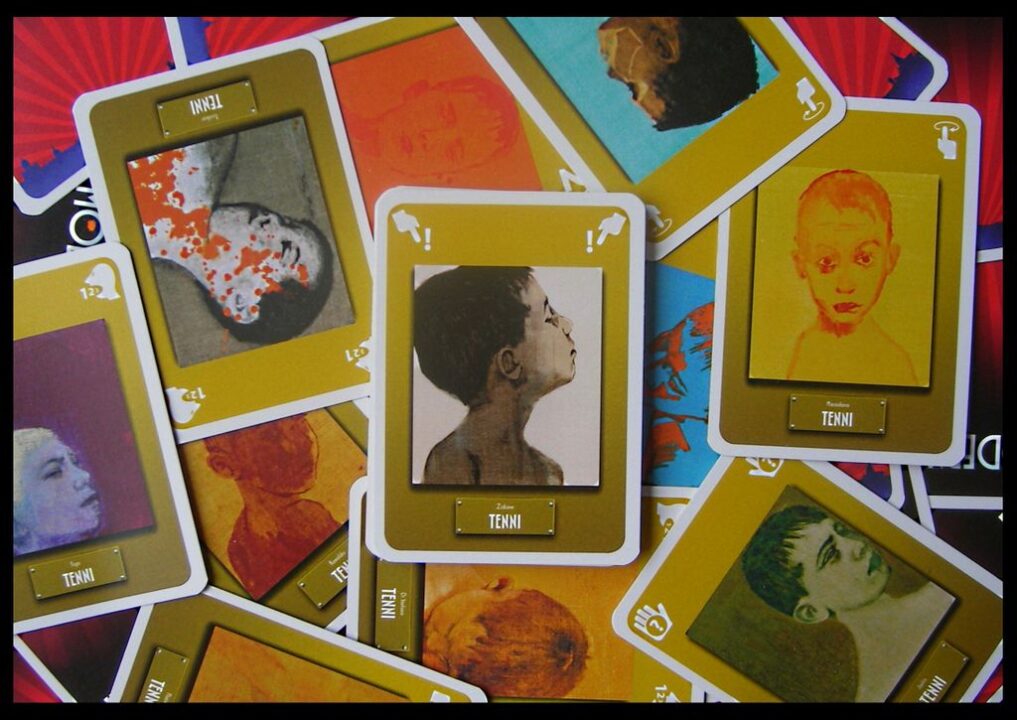
Conclusion
In conclusion, Modern Art is a thrilling and strategic board game that offers a unique and immersive experience in the world of art dealing. The gameplay mechanics, centered around the dynamic auction system, keep players engaged and on their toes. The stunning artwork and visual design enhance the overall experience, making each game a feast for the eyes. The player interaction and strategic depth ensure that no two games are ever the same, providing high replayability and lasting appeal. With its combination of engaging gameplay, beautiful aesthetics, and strategic challenges, Modern Art is a must-have addition to any board game collection.

